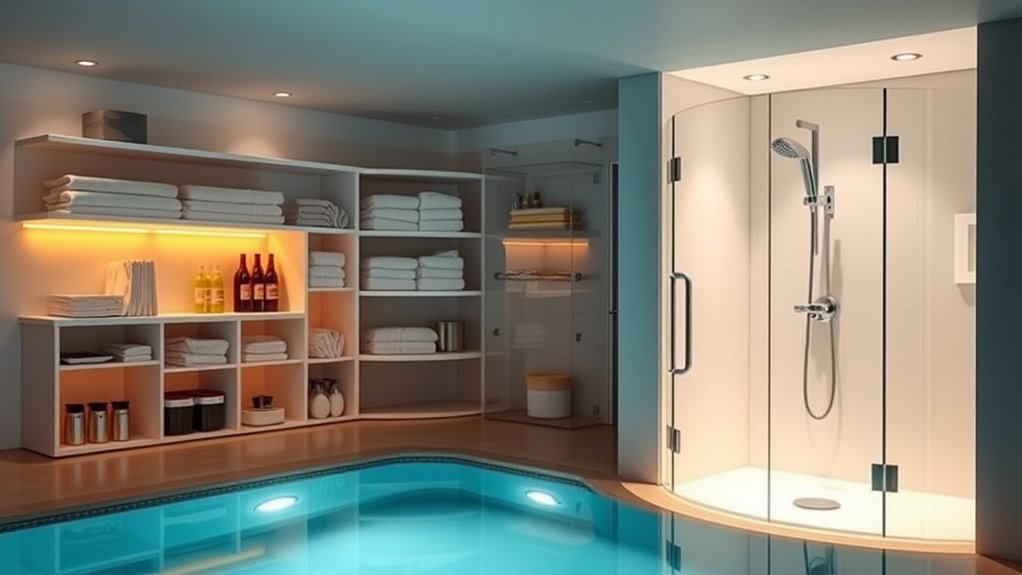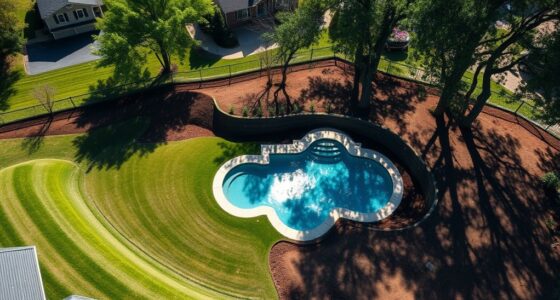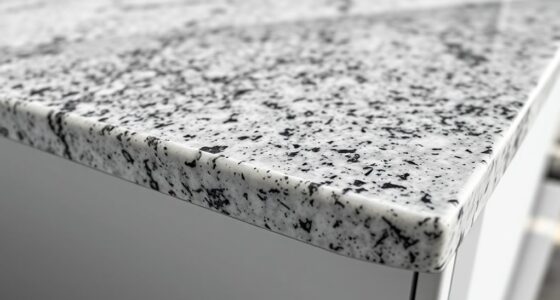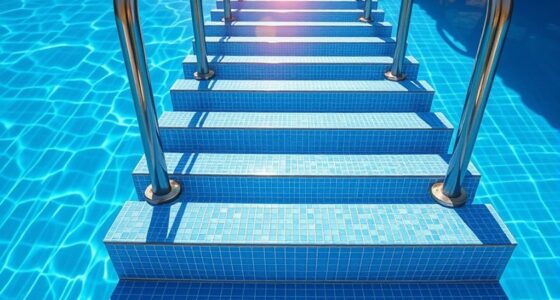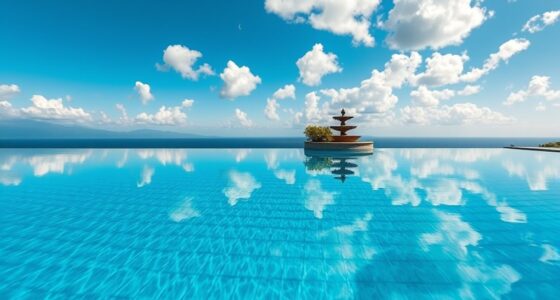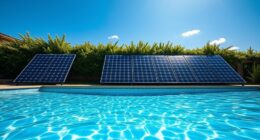When planning your poolhouse, prioritize weather-resistant storage solutions like wall-mounted racks and labeled bins for quick access. Include a practical, easy-to-clean shower area with proper drainage and nearby space for towels. Make certain good ventilation with exhaust fans and consider climate controls for year-round comfort. Don’t forget privacy features like screens or fencing, plus durable, weatherproof materials to withstand the elements. Keep these essentials in mind, and you’ll discover more tips for a complete, functional poolhouse as you continue.
Key Takeaways
- Prioritize weather-resistant storage solutions and vertical organization to keep essentials accessible and protected.
- Design functional, easy-to-maintain showers with proper drainage and nearby towel storage.
- Ensure adequate ventilation and climate control to prevent moisture buildup and maintain comfort year-round.
- Incorporate privacy features and accessible design elements like ramps and wide doorways for all users.
- Use durable, weather-resistant materials for flooring, walls, and fixtures to maximize longevity and reduce maintenance.
Maximizing Storage Solutions for Poolside Essentials
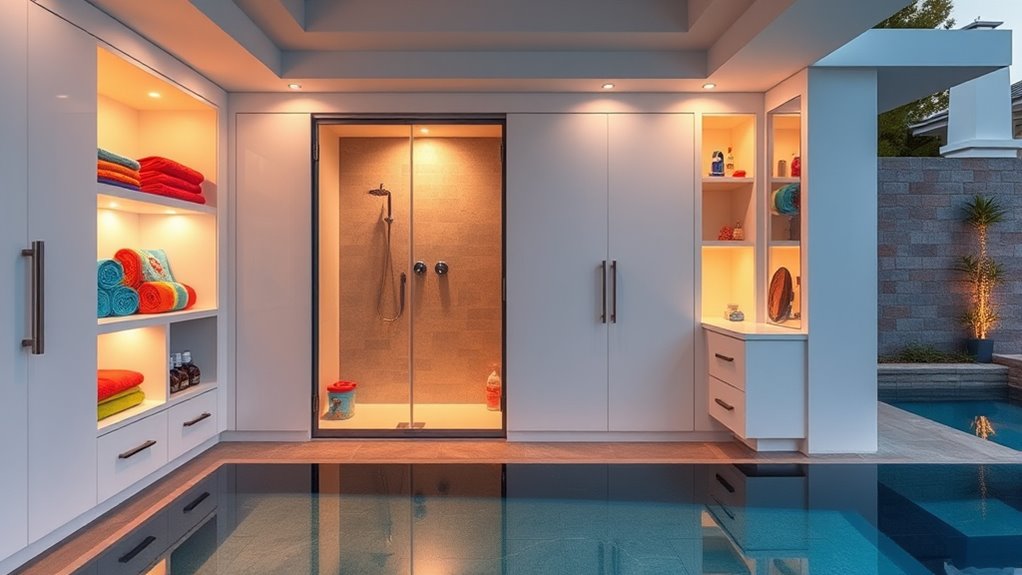
To keep your pool area organized and clutter-free, maximizing storage solutions for poolside essentials is vital. Start by choosing weather-resistant cabinets or storage benches that can withstand outdoor conditions. Use vertical storage options like wall-mounted racks or hooks to hang towels, pool toys, and accessories, freeing up surface space. Consider installing built-in storage units within your poolhouse or around the deck for quick access to floats, cleaning supplies, and safety equipment. Baskets or bins can help compartmentalize smaller items, making them easy to find. Don’t forget to label storage containers for quick identification. Efficient storage not only keeps your area tidy but also ensures everything is readily accessible, so you can spend more time enjoying your pool and less time searching for essentials. Proper color accuracy in your storage labeling and organization can further improve visibility and ease of use.
Incorporating Functional Shower Areas
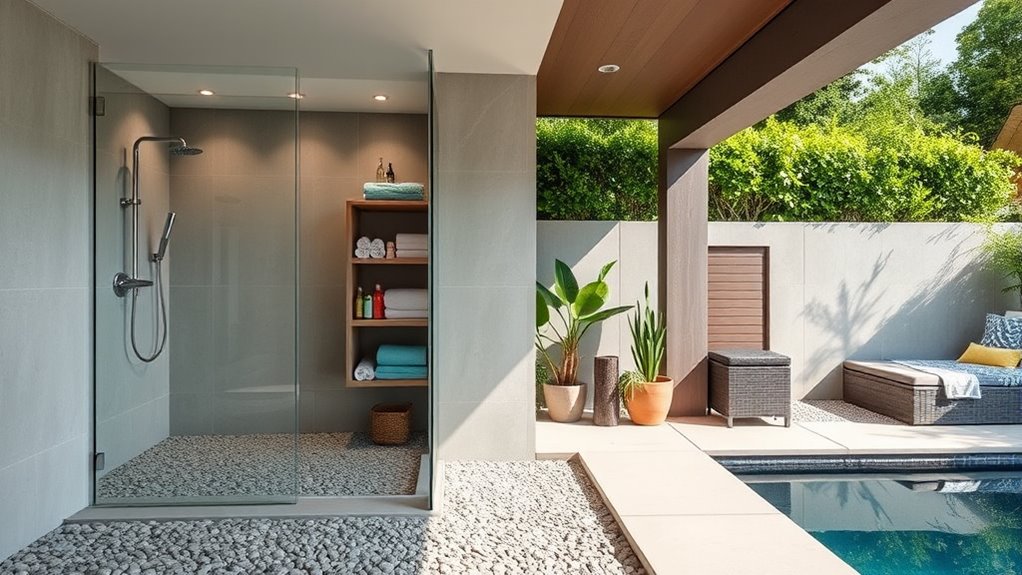
Adding a functional shower area to your poolside setup enhances convenience and keeps your pool deck tidy. It provides a quick rinse before and after swimming, reducing dirt and sand tracked into the pool. To maximize utility, install a durable, easy-to-clean fixture with adjustable water temperature. Consider adding a simple bench or shelf nearby for towels and toiletries. Proper drainage is essential to prevent water pooling and damage. You might also include a privacy screen or curtain for comfort. Position the shower close to the pool but away from lounging areas to avoid splashes. Keep the design simple yet practical, focusing on ease of use and maintenance. A well-planned shower area makes your pool experience more enjoyable and helps maintain a clean, inviting environment.
Planning for Adequate Ventilation and Climate Control
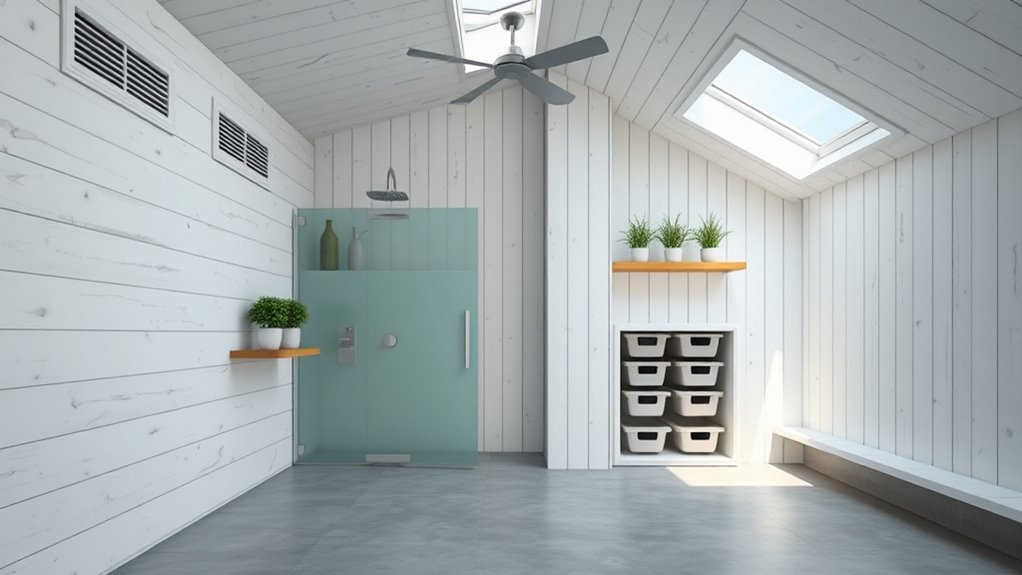
Effective ventilation and climate control are essential to guarantee your poolhouse remains comfortable and free of excess humidity. Proper airflow prevents mold, reduces musty odors, and keeps the space fresh. Install exhaust fans or ventilation hoods near showers and wet areas to quickly remove moisture. Consider a dehumidifier to maintain ideal humidity levels, especially in humid climates. Climate control systems like mini-split HVAC units provide efficient heating and cooling, ensuring comfort year-round. Insulation also plays a crucial role, helping to stabilize temperatures and reduce energy costs. When planning, think about the size of your poolhouse and its use to select appropriate systems. Good ventilation not only boosts comfort but also protects your investment by preventing damage caused by moisture buildup. Juice cleansing techniques can also be useful in maintaining a healthy environment by supporting overall wellness.
Considering Privacy and Accessibility Features
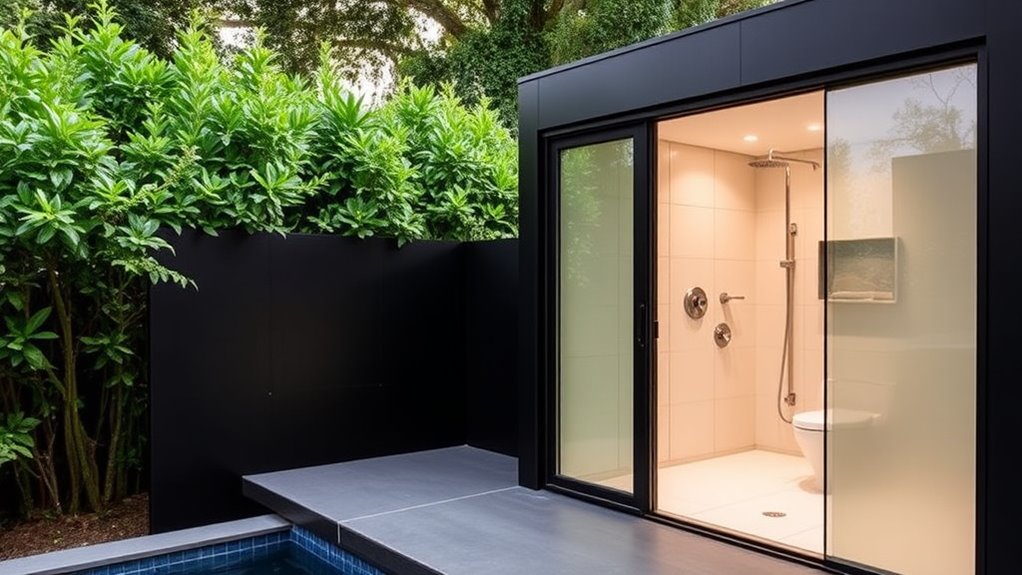
When designing your poolhouse, considering privacy and accessibility features guarantees it meets your needs and respects your space. Prioritize placement to shield changing areas or showers from view, perhaps with fencing or landscaping. Accessibility involves wide doorways, smooth ramps, and non-slip flooring for all users. Think about installing a privacy screen or curtains for flexible concealment. Ensure door handles are reachable and easy to operate, and plan for sufficient lighting. Here’s a quick guide:
| Feature | Consideration | Benefit |
|---|---|---|
| Privacy screens | Block sightlines | Enhanced seclusion |
| Wide doorways | Accommodate mobility aids | Easy access |
| Non-slip flooring | Prevent slips and falls | Safer environment |
| Adjustable lighting | Adjust for privacy and comfort | Versatile usability |
Additionally, reviewing security zone info can help you determine the best placement and features for your poolhouse to maximize safety and privacy.
Selecting Durable Materials for Longevity

Choosing the right materials is essential to guarantee your poolhouse withstands the elements and daily wear over time. Opt for weather-resistant options like composite decking, treated wood, or stone for flooring, which resist moisture and decay. For walls and exteriors, consider fiber cement siding or stucco, both durable against rain, sun, and temperature fluctuations. Use corrosion-resistant metals like aluminum or stainless steel for fixtures and hardware to prevent rust. Inside, select waterproof or moisture-resistant materials such as vinyl or tile for showers and walls. Prioritize quality finishes that won’t peel or fade easily. Investing in durable materials might cost more upfront, but it ensures your poolhouse remains functional and attractive for years, reducing future repairs and replacements. Incorporating ventilation considerations can also help prevent moisture buildup and prolong material lifespan.
Frequently Asked Questions
How Can I Incorporate Eco-Friendly Features Into My Poolhouse Design?
You can incorporate eco-friendly features into your poolhouse by choosing solar panels to power lighting and appliances, installing energy-efficient windows and insulation to reduce heating and cooling needs, and using sustainable materials like bamboo or reclaimed wood for construction. Adding low-flow showerheads and eco-friendly cleaning products minimizes water and chemical use. Incorporate native plants around the pool area to reduce irrigation and support local wildlife, making your poolhouse both stylish and sustainable.
What Are the Legal Building Code Considerations for Poolhouses in My Area?
Imagine your poolside oasis, but before building, you need to check local building codes. You should contact your city or county building department to understand setbacks, height restrictions, and permits required. Confirm your design complies with zoning laws and safety standards. Ignoring these rules can lead to costly delays or penalties. Stay proactive, review your area’s regulations, and get the necessary approvals to enjoy your poolhouse worry-free.
How Should I Budget for Unexpected Construction Costs?
You should budget at least 10-15% extra for unexpected construction costs. Start by setting aside a contingency fund early in your project, and get detailed estimates from your contractor. Keep some flexibility in your budget for unforeseen issues like hidden site problems or material price increases. Regularly review your expenses and communicate with your contractor to stay on top of potential surprises, avoiding financial stress later on.
What Security Measures Are Recommended for Poolhouse Storage Areas?
You should install sturdy locks on all doors and windows, and consider a security system with cameras and motion detectors for your poolhouse storage area. Bright lighting around the perimeter deters intruders, and using reinforced doors adds extra protection. Keep valuable items out of sight, and regularly review your security setup to guarantee it’s working effectively. These measures help safeguard your equipment and supplies from theft or vandalism.
How Can I Optimize Lighting for Both Safety and Ambiance?
You can transform your poolhouse lighting into a magical oasis that’s both safe and stunning. Install layered lighting—bright overhead fixtures for safety and soft accent lights for ambiance. Use dimmers to set the mood easily. Strategically place pathway lights to prevent accidents. Highlight architectural features with spotlights. Keep bulbs energy-efficient to save costs. With the right balance, your poolhouse becomes a paradise of safety and style, inviting relaxation day and night.
Conclusion
As you design your poolhouse, remember that style is important, but functionality is essential. While sleek finishes catch the eye, durability ensures longevity. Privacy matters, yet accessibility opens your space to all. Balancing these elements creates a perfect retreat—where beauty meets practicality. Don’t forget, a well-planned poolhouse isn’t just about aesthetics; it’s about seamlessly blending comfort with durability to enjoy your outdoor oasis for years to come.
